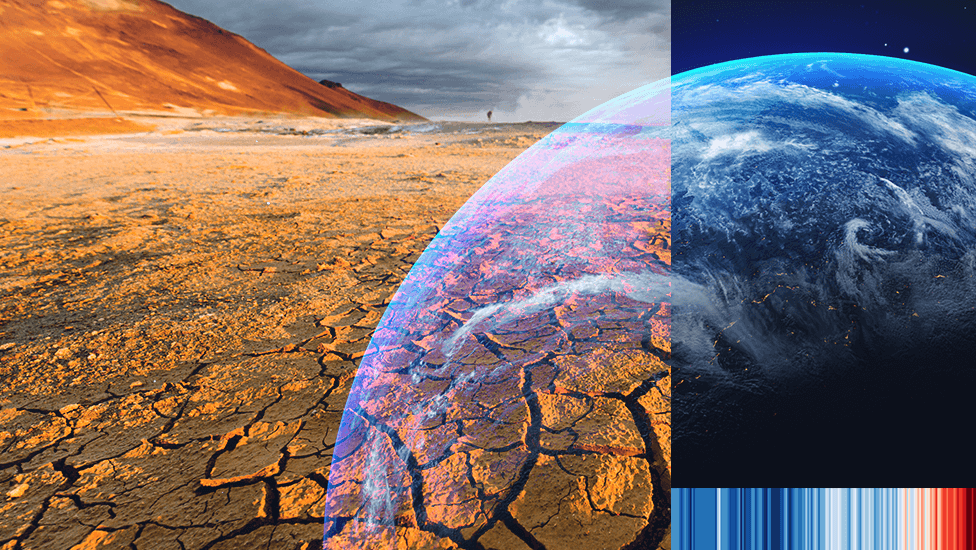





Disclaimer: Copyright infringement not intended.
Context
Details
Key Reasons behind rising temperature of the Earth
The rising temperature of the Earth and the phenomenon of the warmest years can be attributed to various natural and anthropogenic factors. Here are the key reasons behind these trends:
Greenhouse Gas Emissions:
Deforestation:
Increased Industrialization:
Land Use Changes:
Melting of Ice and Snow:
Natural Climate Variability:
Solar Radiation Variability:
Ocean Heat Absorption:
Positive Feedback Loops:
Extreme Weather Events:
|
KEY DATA The concentration of carbon dioxide (CO2) in the atmosphere reached approximately 414 parts per million (ppm) in 2021, significantly higher than pre-industrial levels (around 280 ppm). Example: The Mauna Loa Observatory in Hawaii has been monitoring atmospheric CO2 concentrations since the late 1950s, showing a clear upward trend. Deforestation: Global deforestation rates were estimated at 10 million hectares per year between 2015 and 2020. Example: The Amazon rainforest, a crucial carbon sink, has experienced accelerated deforestation, impacting the global carbon balance. Increased Industrialization: Global carbon dioxide emissions from fossil fuels and industrial processes reached 33.1 billion metric tons in 2019. Example: China, the world's largest emitter, is heavily reliant on coal for energy, contributing significantly to global carbon emissions. Land Use Changes: Urban land area is expected to triple between 2000 and 2030, leading to significant changes in land use patterns. Example: Rapid urbanization in regions like Southeast Asia has led to altered surface properties, affecting local climates. Melting of Ice and Snow: Arctic sea ice extent reached its second-lowest level on record in September 2020, according to the National Snow and Ice Data Center. Example: The retreat of glaciers, such as those in the Himalayas and Alps, is well-documented. Natural Climate Variability: El Niño events, characterized by warmer sea surface temperatures in the central Pacific, occur irregularly but influence global temperatures during their occurrence. Example: The strong El Niño in 2015-2016 contributed to the record warmth observed in those years. Solar Radiation Variability: Solar irradiance variations are relatively small, with an average total solar irradiance of about 1361 watts per square meter. Example: The sunspot cycle, which occurs approximately every 11 years, has a minimal impact on recent warming trends. Ocean Heat Absorption: Oceans have absorbed over 90% of the excess heat generated by human activities since the mid-20th century. Example: Warming oceans contribute to sea level rise and altered marine ecosystems. Positive Feedback Loops: Methane concentrations in the atmosphere surpassed 1877 parts per billion in 2021, an increase from pre-industrial levels. Example: Thawing permafrost in the Arctic releases stored methane, amplifying greenhouse gas concentrations. Extreme Weather Events: The frequency of extreme weather events has increased, with more frequent and severe heatwaves, hurricanes, and wildfires. Example: The 2020 Atlantic hurricane season saw a record number of named storms, a reflection of warmer sea surface temperatures. |
Steps being taken to counter the situation
To counter the situation of global warming and climate change, several steps have been taken at the international level through agreements and climate deals. Here are key initiatives and international agreements aimed at addressing climate change:
Paris Agreement:
Kyoto Protocol:
Montreal Protocol:
Intergovernmental Panel on Climate Change (IPCC):
Green Climate Fund (GCF):
COP26 Glasgow Climate Pact:
Renewable Energy Initiatives:
Global Methane Pledge:
National Climate Action Plans:
Corporate Sustainability Initiatives:
These initiatives and agreements represent collaborative efforts at the global level to address climate change, reduce emissions, and build resilience to its impacts. The success of these efforts depends on continued commitment, cooperation, and implementation by nations, organizations, and individuals worldwide.
Performance of these initiatives
The performance of international initiatives and agreements in addressing climate change is a complex and evolving landscape. While significant strides have been made, challenges persist, and the urgency to accelerate efforts remains. Here's an assessment of the performance and whether we are on the right path:
Positive Aspects:
Increased Awareness:
Renewable Energy Growth:
Paris Agreement Commitments:
Technological Advancements:
Global Methane Pledge:
Youth Activism and Public Pressure:
Challenges and Concerns:
Emission Reduction Gaps:
Limited Implementation:
Incomplete Global Cooperation:
Insufficient Climate Finance:
Deforestation and Land Use Changes:
Carbon Intensive Industries:
Incomplete Transition from Fossil Fuels:
Climate Justice Concerns:
Assessment:
Way Forward
Enhanced Emission Reduction Targets:
Accelerated Transition to Renewable Energy:
Climate Finance Commitments:
Global Collaboration on Technology Transfer:
Protection and Restoration of Forests:
Promotion of Sustainable Agriculture:
Phasing Out Fossil Fuel Subsidies:
Integration of Climate Action into COVID-19 Recovery Plans:
Innovation and Research:
Public Awareness and Education:
Collaboration with the Private Sector:
Adaptation Planning and Climate Resilience:
Youth and Community Engagement:
Transparent Monitoring and Accountability:
Closing Remarks
|
PRACTICE QUESTION Question: Examine the phenomenon of the warmest years in the context of global climate change. Discuss the contributing factors leading to the warming trend and assess the implications for the environment, ecosystems, and human societies. Evaluate the effectiveness of international initiatives in mitigating climate change, considering the challenges and the way forward. Support your answer with relevant data, examples, and case studies. Model Answer: Introduction The phenomenon of the warmest years is a critical aspect of global climate change, reflecting an alarming trend of rising temperatures worldwide. This issue necessitates a comprehensive examination of contributing factors, implications for various aspects of the environment, ecosystems, and human societies, and an evaluation of international efforts to mitigate climate change. II. Contributing Factors to the Warming Trend Human activities are the primary drivers of the warming trend, notably through the excessive release of greenhouse gases (GHGs). The combustion of fossil fuels, such as coal, oil, and natural gas, releases large quantities of carbon dioxide (CO2) into the atmosphere. Additionally, deforestation reduces the planet's capacity to absorb CO2, exacerbating the greenhouse effect. These factors intensify the trapping of heat, leading to a discernible and concerning warming trend. III. Implications for the Environment The consequences of this warming trend are evident in the environmental sphere. The melting of polar ice caps and glaciers contributes to rising sea levels, posing a direct threat to low-lying coastal areas. This sea-level rise results in increased vulnerability, affecting human settlements, agriculture, and biodiversity. Moreover, the alteration of temperature patterns contributes to more frequent and severe extreme weather events, amplifying the challenges faced by ecosystems and societies. IV. Implications for Ecosystems Ecosystems worldwide face disruptions due to changing temperatures. Coral reefs, critical for marine biodiversity, experience bleaching events as a consequence of warmer seas. The interconnected nature of ecosystems exacerbates challenges for species adaptation and survival, leading to biodiversity loss. V. Implications for Human Societies Human societies are significantly impacted by the warming trend. Agricultural productivity is at risk due to changing climate patterns, threatening food security. Coastal regions face increased threats, with rising sea levels jeopardizing infrastructure and displacing communities. Extreme weather events, influenced by global warming, result in economic losses and disrupt daily life. VI. Evaluation of International Initiatives Efforts to address climate change are evident in international initiatives such as the Paris Agreement. While these initiatives represent a collective commitment to mitigation, challenges persist. Varied commitment levels among nations, insufficient financial support for developing countries, and slow technological innovation hinder overall progress. VII. Challenges in Climate Mitigation Addressing climate change faces challenges, including disparities in national commitments, the inadequacy of climate finance, and the slow pace of technological advancements. Despite international agreements, global carbon emissions continue to rise, underscoring the urgency of more robust action. VIII. The Way Forward To enhance the effectiveness of international initiatives, a holistic approach is essential. This involves setting more ambitious emission reduction targets, increasing climate finance and technology transfer to support developing nations, and adopting sustainable practices across sectors. IX. Case Studies and Examples Examining case studies and examples of successful climate mitigation efforts provides insights into effective strategies. Instances where nations have made significant strides in reducing emissions or adapting to climate impacts showcase the potential for positive change. X. Conclusion In conclusion, the warmest years phenomenon is a critical manifestation of global climate change with far-reaching implications. Addressing this challenge requires urgent and concerted efforts, emphasizing the need for enhanced international collaboration, stringent emission reduction measures, and sustainable practices across sectors. |







© 2025 iasgyan. All right reserved